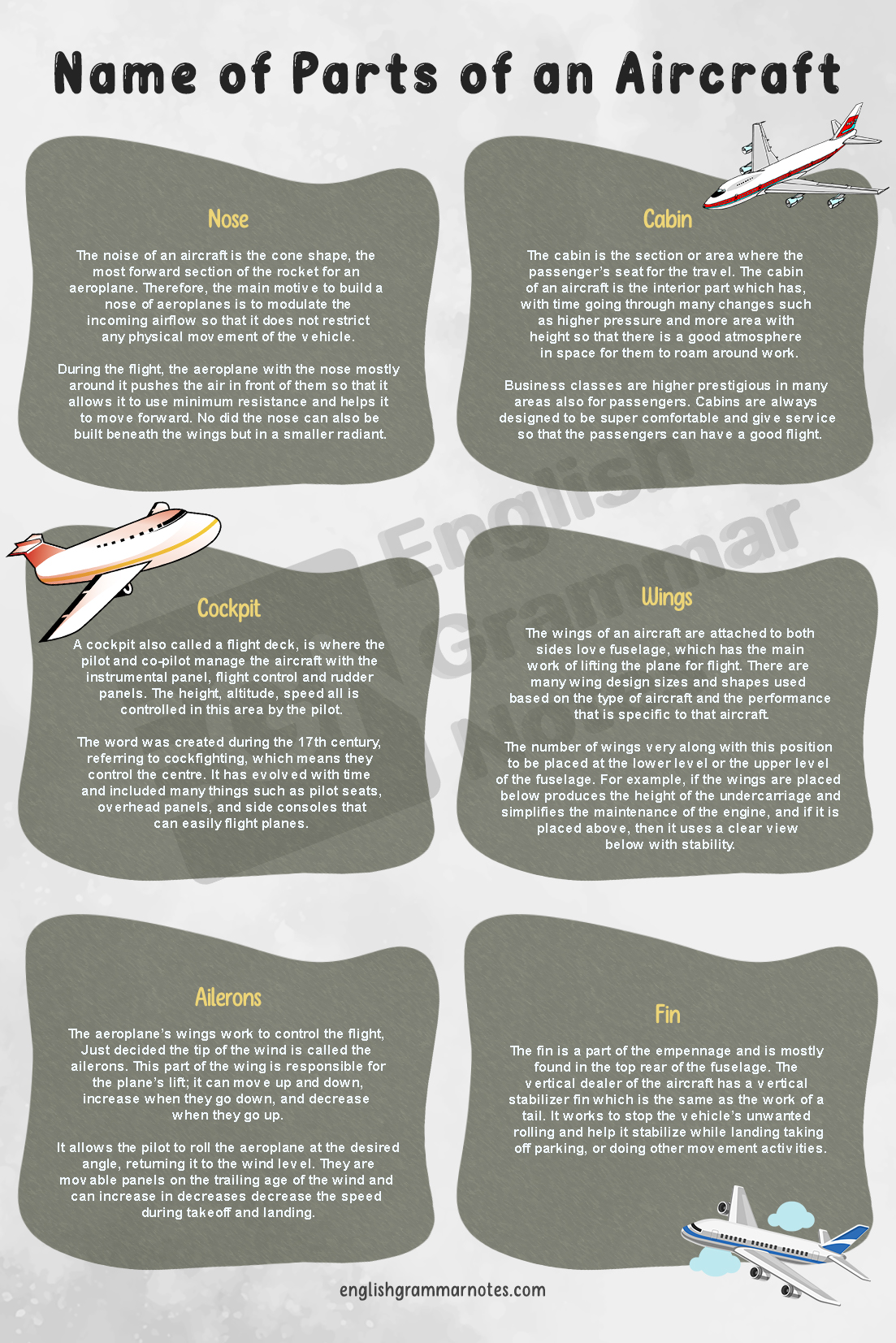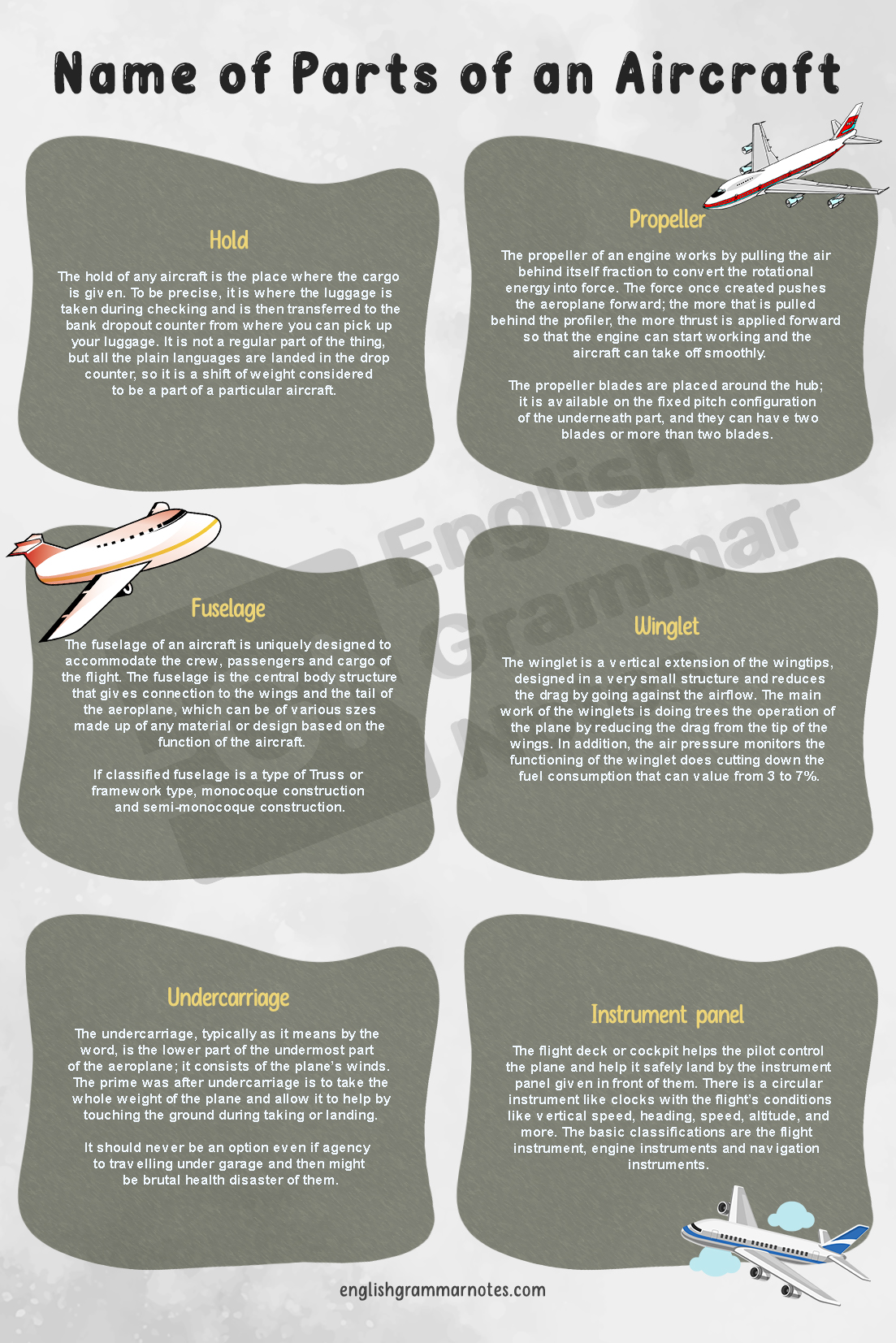Parts of an Aircraft: With humans’ evolution, many forms of vehicles have evolved and contributed to the transport industry to move men from one place to another.
In the beginning, what we knew was only the land and waterways of transportation, but with time a machine is capable of flying in the air, which is popularly called in aircraft; aircraft includes helicopters, aeroplanes, hot air balloons, anything which flies in the air.
There are various reasons you should know about the parts of an aeroplane and their functions, the first of which is because of travelling. The other one is if you work in the transport industry or are associated with the interiors of an aircraft. There are various interior parts of aircraft which is very much accustomed with the flight attendants, but surely is not much known to commoners.
Study the most important English Vocabulary Words identified by our experts and learn the right vocabulary to use in your day to day conversations
With time there is more places and scopes to enhance knowledge and vocabulary in English. If you are boarding to take a flight and want to avoid any mishaps, you should know about the few parts of an aircraft to enhance your knowledge. We have thus taken a few names and made a list of parts of an aircraft for you.
List of Parts of an Aircraft
Name of Parts of an Aircraft
- Nose
- Cabin
- Cockpit
- Wings
- Ailerons
- Empennage
- Fin
- Hold
- Propeller
- Fuselage
- Elevator
- Engine
- Turbine engine
- Winglet
- Landing gear
- Undercarriage
- Instrument panel
Description of Parts of an Aircraft on the list
Nose
The noise of an aircraft is the cone shape, the most forward section of the rocket for an aeroplane. Therefore, the main motive to build a nose of aeroplanes is to modulate the incoming airflow so that it does not restrict any physical movement of the vehicle.
During the flight, the aeroplane with the nose mostly around it pushes the air in front of them so that it allows it to use minimum resistance and helps it to move forward. No did the nose can also be built beneath the wings but in a smaller radiant.
Cabin
The cabin is the section or area where the passenger’s seat for the travel. The cabin of an aircraft is the interior part which has, with time going through many changes such as higher pressure and more area with height so that there is a good atmosphere in space for them to roam around work.
Business classes are higher prestigious in many areas also for passengers. Cabins are always designed to be super comfortable and give service so that the passengers can have a good flight.
Cockpit
A cockpit also called a flight deck, is where the pilot and co-pilot manage the aircraft with the instrumental panel, flight control and rudder panels. The height, altitude, speed all is controlled in this area by the pilot.
The word was created during the 17th century, referring to cockfighting, which means they control the centre. It has evolved with time and included many things such as pilot seats, overhead panels, and side consoles that can easily flight planes.
Wings
the wings of an aircraft are attached to both sides love fuselage, which has the main work of lifting the plane for flight. There are many wing design sizes and shapes used based on the type of aircraft and the performance that is specific to that aircraft.
The number of wings very along with this position to be placed at the lower level or the upper level of the fuselage. For example, if the wings are placed below produces the height of the undercarriage and simplifies the maintenance of the engine, and if it is placed above, then it uses a clear view below with stability.
Ailerons
The aeroplane’s wings work to control the flight, Just decided the tip of the wind is called the ailerons. This part of the wing is responsible for the plane’s lift; it can move up and down, increase when they go down, and decrease when they go up.
It allows the pilot to roll the aeroplane at the desired angle, returning it to the wind level. They are movable panels on the trailing age of the wind and can increase in decreases decrease the speed during takeoff and landing.
Empennage
The empennage is the entire section with fixed surfaces to width like the vertical stabilizer and horizontal stabilizers. The horizontal empennage has a horizontal stabilizer with an elevator behind it, and a vertical empennage has a vertical stabilizer with a rudder at its back.
The empennage is also called a tail of the aircraft; the main work of this part in the aircraft is to help the aircraft guide to reach the destination. In addition, they are of slightly higher construction and different composition, so they can help in stabilizing their craft when in flight.
Fin
The fin is a part of the empennage and is mostly found in the top rear of the fuselage. The vertical dealer of the aircraft has a vertical stabilizer fin which is the same as the work of a tail. It works to stop the vehicle’s unwanted rolling and help it stabilize while landing taking off parking, or doing other movement activities.

Hold
The hold of any aircraft is the place where the cargo is given. To be precise, it is where the luggage is taken during checking and is then transferred to the bank dropout counter from where you can pick up your luggage. It is not a regular part of the thing, but all the plain languages are landed in the drop counter, so it is a shift of weight considered to be a part of a particular aircraft.
Propeller
The propeller of an engine works by pulling the air behind itself fraction to convert the rotational energy into force. The force once created pushes the aeroplane forward; the more that is pulled behind the profiler, the more thrust is applied forward so that the engine can start working and the aircraft can take off smoothly.
The propeller blades are placed around the hub; it is available on the fixed pitch configuration of the underneath part, and they can have two blades or more than two blades.
Fuselage
The fuselage of an aircraft is uniquely designed to accommodate the crew, passengers and cargo of the flight. The fuselage is the central body structure that gives connection to the wings and the tail of the aeroplane, which can be of various sizes made up of any material or design based on the function of the aircraft.
If classified fuselage is a type of Truss or framework type, monocoque construction and semi-monocoque construction.
Elevator
The elevator of her plane is the movable part of the aircraft; still, it helps to move the plane up and down. As the deal of the plane cannot move on its own, the elevator helps the deal move upward does interactively, helping the aeroplane start when the pilot presses the button.
There are two types of elevators, one mounted on the trailers and the other on the horizon stabilizer. Countries the movement of the last relaxes of the aircraft or what we can call as the pitch.
Engine
An aircraft engine is also known as an aero-engine, is the sole Power House of the aircraft. Engines have different components of power life piston engine, gas engine, the rocket-powered engine also there are three types of aeroplane engines namely turbojet, turbofan and turboprop, turbine, engine.
The engine of air plains is located just beneath the wings that provide methods to overcome what the aeroplane faces when they take off from land by pushing away the air. They typically run on Aviation gasoline to allow a higher compression rate during flight.
Turbine engine
Most of the aeroplanes in jets have a large gas engine called the turbine engine for air-breathing. The work of this engine is true to extract the energy of the conversion gases by any combustion engine gas. It describes the real part, which consists of a compressor conversion chamber and a turbine that can furnish the power to drive the plane.
If, in any case, the turbine engine flows or there is a drop in its activity, then it means it has absorbed a very large portion of combustion gas energy, and this cannot transfer it to the compressor.
Winglet
The winglet is a vertical extension of the wingtips, designed in a very small structure and reduces the drag by going against the airflow. The main work of the winglets is doing trees the operation of the plane by reducing the drag from the tip of the wings. In addition, the air pressure monitors the functioning of the winglet does cutting down the fuel consumption that can value from 3 to 7%.
Landing gear
The excellent work of a landing gear of the year craft is to give support when parked, taking off and landing. Every aeroplane doesn’t need to have landing gear; it can also have operators of skis to help it at water or snow. It has a shock absorber, wheel, brake and undercarriage that help to observe the lending impact of energy and load transfer.
There are mostly three types of gear that are tail wheel-type landing gear, tandem landing gear and tricycle type landing.
Undercarriage
The undercarriage, typically as it means by the word, is the lower part of the undermost part of the aeroplane; it consists of the plane’s winds. The prime was after undercarriage is to take the whole weight of the plane and allow it to help by touching the ground during taking or landing.
It should never be an option even if agency to travelling under garage and then might be brutal health disaster of them.
Instrument panel
The flight deck or cockpit helps the pilot control the plane and help it safely land by the instrument panel given in front of them. There is a circular instrument like clocks with the flight’s conditions like vertical speed, heading, speed, altitude, and more. The basic classifications are the flight instrument, engine instruments and navigation instruments.
